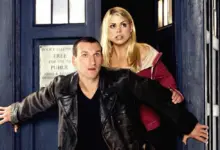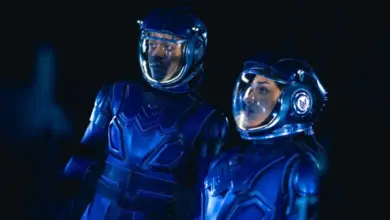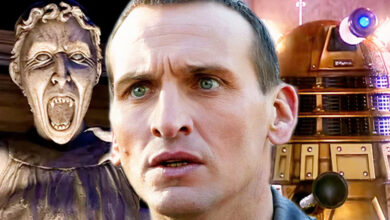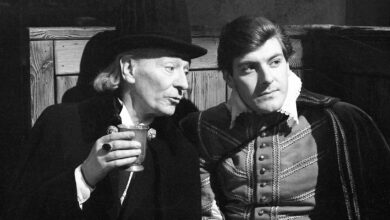The magic of two Tom Baker serials from the mid-1970s was never quite replicated.

It’s not exactly contentious to suggest that the Tom Baker era of Doctor Who produced some of the finest stories in the series’ long run, including both the classic era (1963-89) and the revival (2005-present) – it’s one of the many reasons why fans worldwide will be marking the beloved actor’s 91st birthday today (20th January).
But while there are many terrific stories from across Baker’s seven-year tenure as the Fourth Doctor which fans will contend are among the show’s best, if not the best – 1975’s chilling origin tale Genesis of the Daleks, the following year’s gripping conspiracy thriller The Deadly Assassin, or the witty and charming Douglas Adams-penned City of Death from 1979 – there are a pair of serials from Doctor Who’s 13th season which stand out from the crowd not just by virtue of their quality but because they feel very much of a piece and equally quite unlike any other story in the show’s history.
Terror of the Zygons first aired across four weeks in August/September 1975. The season opener of Tom Baker’s second year, it sees the Fourth Doctor, Sarah Jane Smith (Elisabeth Sladen), and Harry Sullivan (Ian Marter) investigate the destruction of oil rigs in Scotland, discovering that shapeshifting alien Zygons are using a cyborg-enhanced sea creature, the Skarasen, to execute their plan to conquer Earth.
Closing out the season was The Seeds of Doom, a six-parter which spanned from January to March, 1976. Here, the Doctor and Sarah – now sans Harry – encounter an alien pod in Antarctica that unleashes a galactic weed called the Krynoid, capable of consuming all animal life.
-
Something needs to change for Doctor Who1 week ago
50 years on from original broadcast, both stories remain hugely popular with fans – and what sets them apart from their contemporaries is a unique chemistry that gifts these two stories, and only these two, a unique and wonderful flavour.
Doctor Who removes two classic Tom Baker stories from BBC iPlayer

Both are, of course, fronted by Tom Baker and Elisabeth Sladen, universally lauded as one of Doctor Who’s greatest Doctor/companion pairings. A year in, it’s clear how comfortable each is with the other – their dynamic somehow both fizzles and has the wonderfully relaxed quality of genuine friendship. So winning is their on-screen relationship that one of the few shortcomings in The Seeds of Doom – a closing scene famous for a plot gaffe and an incomprehensible exchange between the Doctor and Sarah – is often forgiven simply because Baker and Sladen seem to be having so much fun in it, bursting into what appears to be an authentic bout of shared laughter as the credits begin to roll.
The two stories also share a director in Douglas Camfield. Though he helmed many other serials in the show’s canon, going all the way back to the William Hartnell era, Camfield’s direction of Terror of the Zygons and The Seeds of Doom exemplifies the traits that have made him one of Doctor Who’s most revered directors, with both stories displaying his talent for creating atmosphere, managing action, and eliciting strong performances.
A moody and atmospheric tale, Terror of the Zygons – which saw Camfield return to the show following a five-year absence – is often praised for its blend of suspense, horror, and character-driven drama and his direction plays a crucial role in elevating this story to classic status.
Likewise, The Seeds of Doom showcases his ability to direct action-packed, suspenseful episodes while maintaining a strong focus on character and atmosphere, and the end result is one of the most dynamic and thrilling classic Doctor Who stories.
Camfield’s contribution to The Seeds of Doom is thought to have been especially marked – having originally been hired to direct another story which was later postponed, he had already begun location scouting by the time script work began on its eventual replacement and so is said to have played a significant role in shaping The Seeds of Doom’s development.
What makes this pair of stories unique though, in tandem with their director and two leads, are the creative mind of writer Robert Banks Stewart and the musical mastery of Geoffrey Burgon.
Banks Stewart is best known outside of Doctor Who fandom as the creator of popular BBC crime series Bergerac (1981-91) and Shoestring (1979-80) and was hired by new script editor Robert Holmes as part of a drive to recruit new writers to the programme.
Holmes’s influence on these two stories should not be understated – he’s said in particular to have worked closely with Banks Stewart on Terror of the Zygons, unfamiliar as the writer then was with Doctor Who’s protagonists and narrative style, and The Seeds of Doom’s aping of 1951 film horror The Thing from Another World in its opening two episodes feels like pure Holmes.
That said, Banks Stewart’s knack for crafting thrilling storylines with complex characters, blending genres, and making the most of rich, atmospheric settings are a huge part of what make his Doctor Who outings so memorable. Those ingredients which would see him go on to great success in later years – how the Jersey-set Bergerac juxtaposed crime drama and its conflicted protagonist against an idyllic setting – are already present here, be it in Terror of the Zygons’ eerie Scottish setting and its blending of folklore with alien invasion themes or in The Seeds of Doom’s fusion of something approaching a James Bond thriller with ecological science-fiction.

Finally, both stories are brought alive by the moody, haunting musical compositions of composer Geoffrey Burgon – noted for its atmospheric and minimalist qualities, his work here perfectly complements the darker and suspenseful tone of these episodes.
His distinctive approach to scoring Doctor Who combined classical influences with innovative use of limited resources, employing a small ensemble of acoustic instruments – including flute, clarinet, harp, violin, cello, and clavichord – then working with the BBC Radiophonic Workshop’s Dick Mills who incorporated electronic effects to produce otherworldly results, contributing to these adventures’ unique soundscape.
Though Doctor Who was blessed to have Baker and Sladen on board for several years, and Douglas Camfield would work on nine different stories in total, Banks Stewart and Burgon would never contribute to the show again after The Seeds of Doom – the former was considered to write a third story but a scheduling clash meant it never materialised, while the latter would go on to achieve considerable acclaim and award success in both film and television, writing the music for Monty Python’s Life of Brian (1979) and winning two Ivor Novello Awards for his work on the series adaptations of Tinker Tailor Soldier Spy (1979) and Brideshead Revisited (1981), as well as a BAFTA for The Forsyte Saga (2002-03).
The team of Baker, Sladen, Camfield, Burgon and Banks Stewart (assisted by Holmes, and all overseen of course by producer Philip Hinchcliffe) was never to be reunited, leaving us with two Doctor Who stories that bookend one of the show’s best-loved seasons and that have a feel, flavour and appeal all of their own.
The chemistry of all these elements combined was a one-off and never repeated or successfully imitated, giving us classic Doctor Who at perhaps its absolute peak.








